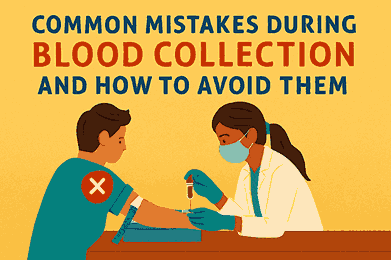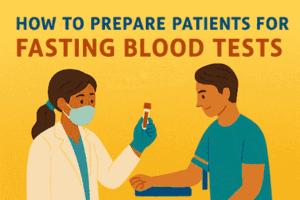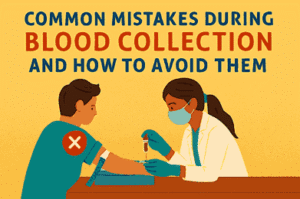Medical
accurate blood collection, avoiding phlebotomy errors, blood collection, blood draw errors, blood sample handling, common phlebotomy mistakes, healthcare safety, laboratory safety, patient care, phlebotomist guide, phlebotomy, phlebotomy best practices, phlebotomy tips, phlebotomy training, Tooba Khalil, venipuncture mistakes
Tooba Khalil
0 Comments
Common Mistakes During Blood Collection and How to Avoid Them

Blood collection is one of the most routine procedures in healthcare. Every day, millions of blood samples are drawn for diagnostic testing, disease monitoring, and medical research. Although phlebotomy may appear simple, even minor errors during the process can affect the accuracy of test results, compromise patient safety, and lead to repeated procedures that cause discomfort and anxiety. For healthcare providers and phlebotomists, understanding common mistakes during blood collection and learning how to avoid them is essential for maintaining high standards of patient care.
In this article, we will discuss the most frequent errors in blood collection, their consequences, and practical steps to ensure safe and effective venipuncture.
1. Inadequate Patient Identification
One of the most serious mistakes in blood collection is failing to properly identify the patient. Collecting a sample from the wrong person or labeling the tube incorrectly can lead to misdiagnosis and inappropriate treatment. The World Health Organization emphasizes patient identification as the first and most important step in any medical procedure.
How to avoid it: Always confirm patient identity using at least two identifiers, such as full name and date of birth. Cross-check the information with the laboratory request form before proceeding. Clearly label tubes in the presence of the patient to minimize the chance of mix-ups.
2. Poor Site Selection
Choosing the wrong vein or puncture site is another frequent mistake. For example, drawing from areas with scars, hematomas, or near intravenous lines can affect sample quality. Additionally, repeatedly using the same vein can cause vein damage and long-term complications for the patient.
How to avoid it: The median cubital vein in the antecubital fossa is usually the preferred site. Avoid sites with visible complications, and rotate puncture sites when patients require frequent blood draws. If a patient has a condition such as lymphedema or mastectomy on one side, never draw from the affected arm.
3. Incorrect Order of Draw
Laboratories often process multiple blood samples collected in different tubes, each containing specific additives. Drawing blood in the wrong order can cause cross-contamination of additives, leading to inaccurate test results. For instance, anticoagulants from one tube may interfere with clotting studies if tubes are collected in the wrong sequence.
How to avoid it: Always follow the standardized order of draw recommended by the Clinical and Laboratory Standards Institute (CLSI). Begin with blood culture bottles, followed by coagulation tubes, serum tubes, heparin tubes, EDTA tubes, and finally glycolytic inhibitor tubes. This sequence ensures minimal risk of cross-contamination.
4. Using the Wrong Needle Size
Selecting an inappropriate needle size can result in hemolysis, collapsed veins, or unnecessary patient discomfort. Using a needle that is too large may damage the vein, while one that is too small may cause slow blood flow and sample clotting.
How to avoid it: Choose needle size based on the patient’s vein condition, age, and the type of test required. A 21- or 22-gauge needle is suitable for most adult patients. For children, elderly patients, or those with fragile veins, smaller butterfly needles may be more appropriate.
5. Prolonged Tourniquet Application
Leaving the tourniquet on for too long can cause hemoconcentration, which alters test results by falsely elevating protein, enzyme, or electrolyte levels. In addition, extended tourniquet application increases patient discomfort and risk of bruising.
How to avoid it: Apply the tourniquet no longer than one minute before inserting the needle. Release it as soon as blood begins to flow into the collection tube. If difficulty arises in finding a vein, remove the tourniquet and allow circulation to return before reapplying.
6. Failure to Follow Proper Aseptic Technique
Poor hand hygiene, improper glove use, or failure to clean the puncture site thoroughly can introduce infection. This is a critical safety issue, especially for immunocompromised patients.
How to avoid it: Always wash hands or use hand sanitizer before and after the procedure. Wear gloves consistently, and use alcohol swabs or antiseptic solutions to clean the puncture site. Allow the area to dry completely before inserting the needle to reduce the risk of contamination.
7. Inadequate Tube Filling
Partially filled tubes are another common error. Many tubes contain additives in precise amounts designed for a specific volume of blood. Underfilling disrupts the ratio of blood to additive, potentially leading to incorrect test results, especially in coagulation studies.
How to avoid it: Ensure that vacuum tubes are filled to the correct volume. Observe the manufacturer’s markings on the tube, and do not remove the needle until blood flow stops naturally. If a tube fails to fill, replace it with another of the same type rather than attempting to force blood flow.
8. Vigorous Mixing or Shaking of Tubes
While blood samples in additive tubes need gentle mixing to prevent clotting, excessive shaking can cause hemolysis. Hemolyzed samples often appear red or pink and can interfere with many laboratory tests.
How to avoid it: Gently invert tubes the recommended number of times, usually between 5 to 10 inversions, depending on the tube type. Avoid vigorous shaking or tapping.
9. Lack of Communication with Patients
Anxiety, fear of needles, or lack of preparation can make the procedure more difficult. Some patients may faint, pull away, or become uncooperative during venipuncture. Failure to communicate effectively increases the likelihood of complications.
How to avoid it: Explain the procedure in simple terms before starting. Encourage patients to relax and breathe normally. For those prone to fainting, perform the procedure with the patient in a reclined or lying position. Patient-centered communication not only builds trust but also improves the overall experience.
10. Improper Handling and Transport of Samples
Even after a successful collection, mishandling during transport can compromise sample quality. Exposing tubes to extreme temperatures, delays in processing, or rough handling can lead to hemolysis, clotting, or bacterial contamination.
How to avoid it: Follow laboratory guidelines for proper storage and transport. Place samples in biohazard bags, maintain appropriate temperature conditions, and deliver them to the laboratory promptly. Handle tubes gently to prevent cell damage.
Why Avoiding Mistakes Matters
Every step of the blood collection process has a direct impact on patient care. Errors not only lead to repeated venipunctures but also risk misdiagnosis, delayed treatment, and patient dissatisfaction. For healthcare institutions, mistakes increase costs, reduce efficiency, and may even result in legal consequences. By adhering to best practices, phlebotomists and healthcare workers can ensure accurate results, enhance patient safety, and maintain trust in medical systems.
Conclusion
Blood collection is a vital component of medical diagnostics, yet it requires careful attention to detail. From patient identification to sample transport, each step holds the potential for error. However, with proper training, adherence to guidelines, and strong communication skills, most mistakes can be easily avoided. Phlebotomists play a critical role in bridging the gap between patients and laboratories, and their diligence ensures that healthcare decisions are based on reliable data. By avoiding common mistakes in blood collection, professionals not only improve test accuracy but also strengthen the quality of care provided to patients.
Tag
accurate blood collection avoiding phlebotomy errors blood collection blood draw errors blood sample handling common phlebotomy mistakes healthcare safety laboratory safety patient care phlebotomist guide phlebotomy phlebotomy best practices phlebotomy tips phlebotomy training Tooba Khalil venipuncture mistakes













Post Comment